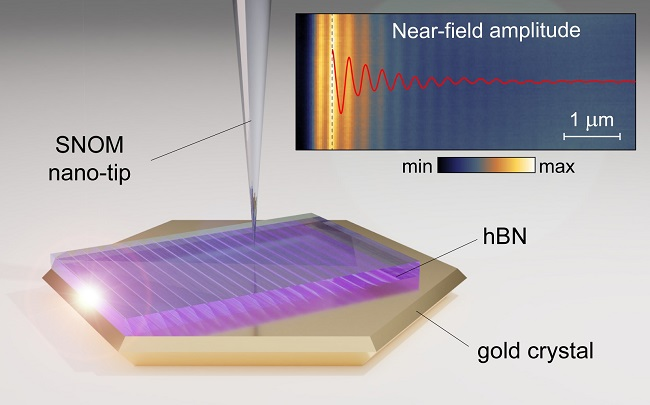For the first, a high-resolution scattering-type scanning near-field optical microscope was used to study highly compressed mid-infrared optical waves in a thin dielectric crystal on a monocrystalline gold substrate.
 Nano-tip is used for the ultra-high-resolution imaging of the image phonon-polaritons in hBN launched by the gold crystal edge. Image Credit: Korea Advanced Institute of Science and Technology (KAIST)
Nano-tip is used for the ultra-high-resolution imaging of the image phonon-polaritons in hBN launched by the gold crystal edge. Image Credit: Korea Advanced Institute of Science and Technology (KAIST)
A new method for steering compressed light waves in ultra-thin van der Waals crystals has been successfully demonstrated by researchers from KAIST and their collaborators at home and overseas.
Their ability to efficiently direct mid-infrared light might open up new possibilities for using ultra-thin dielectric crystals in next-generation optoelectronic devices that rely on potent light-matter interactions at the nanoscale.
The collective oscillations of ions in polar dielectrics known as phonon-polaritons are related to electromagnetic waves of light, whose electromagnetic field is significantly more compressed than the wavelength of light.
Placing a thin van der Waals crystal on top of a highly conductive metal has recently been shown to further compress the phonon-polaritons within the crystal. A novel class of polariton waves known as image phonon-polaritons is produced when charges from the polaritonic crystal are coupled with light in such a configuration and “reflected” in the metal.
Although highly compressed image modes offer powerful light-matter interactions, they are constrained in their practical use by how sensitive they are to substrate roughness.
Due to these restrictions, four research teams collaborated to create a novel experimental platform combining cutting-edge manufacturing and measurement techniques. Their research was published on July 13th, 2022, in Science Advances.
Using a highly sensitive scanning near-field optical microscope (SNOM), a research team from KAIST led by Professor Min Seok Jang from the School of Electrical Engineering was able to directly evaluate the optical fields of the hyperbolic image phonon-polaritons (HIP) propagating in a 63 nm-thick slab of hexagonal boron nitride (h-BN) on a monocrystalline gold substrate, revealing the dielectric crystal compressed hundred-fold mid-infrared light waves.
The signal from the ultra-compressed high-order HIP in a standard h-BN crystal was discovered by Professor Jang and Sergey Menabde, a research professor in his lab, who were successful in obtaining direct images of HIP waves propagating over several wavelengths.
They demonstrated that van der Waals crystal phonon-polaritons could be much more compressed without losing lifespan.
This was made feasible by the home-grown gold crystals employed as a substrate for the h-BN having atomically flat surfaces. A low-loss environment is created for the HIP propagation by almost negligible surface scattering and incredibly minimal ohmic loss in gold at mid-infrared frequencies.
The HIP mode that the researchers investigated had a lifetime comparable to the phonon-polaritons with a low-loss dielectric substrate but was 2.4 times more compressed, giving it a twice greater figure of merit in terms of the normalized propagation length.
The team of Professor N. Asger Mortensen from the Center for Nano Optics at the University of Southern Denmark chemically generated the ultra-smooth monocrystalline gold flakes utilized in the experiment.
Since many significant organic compounds exhibit absorption lines in the mid-infrared, the mid-infrared spectrum is extremely vital for sensing applications.
The ultra-compressed phonon-polariton fields, on the other hand, can provide strong light-matter interactions at the microscopic level, thereby significantly improving the detection limit down to a single molecule. Conventional detection methods require a large number of molecules for successful operation.
The HIP on monocrystalline gold has a long lifespan, which will enhance detection performance even further.
In addition, the research carried out by Professor Jang and his team revealed a remarkable likeness between the HIP and the picture graphene plasmons. Despite having electromagnetic fields that are noticeably more tightly packed, both image mode’s lifespan is impacted by the reduced polariton wavelength.
This finding broadens the understanding of image polaritons in general and emphasizes how they outperform low-dimensional polaritons in van der Waals crystals on a dielectric substrate in terms of waveguiding nano light.
Our research demonstrated the advantages of image polaritons, and especially the image phonon-polaritons. These optical modes can be used in the future optoelectronic devices where both the low-loss propagation and the strong light-matter interaction are necessary.
Min Seok Jang, Professor, School of Electrical Engineering, Korea Advanced Institute of Science and Technology
Jang added, “I hope that our results will pave the way for the realization of more efficient nanophotonic devices such as metasurfaces, optical switches, sensors, and other applications operating at infrared frequencies.”
The National Research Foundation of Korea (NRF) and the Samsung Research Funding & Incubation Center of Samsung Electronics provided funding for this study.
The study was further supported by the Korea Institute of Science and Technology, the Ministry of Education, Culture, Sports, Science, and Technology of Japan, and The Villum Foundation of Denmark.
Journal Reference:
Menabde, S. G., et al. (2022) Near-field probing of image phonon-polaritons in hexagonal boron nitride on gold crystals. Science Advances. doi:10.1126/sciadv.abn0627.